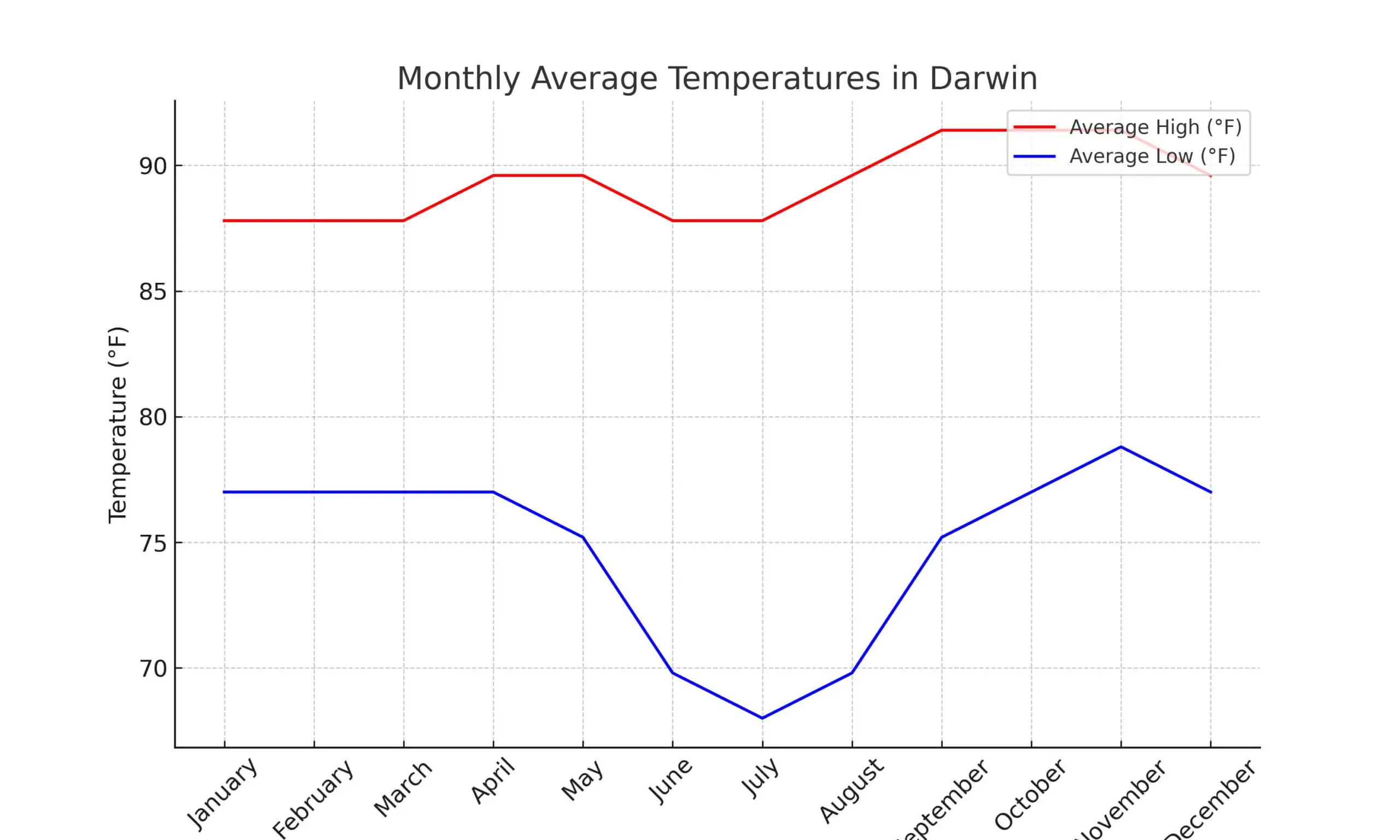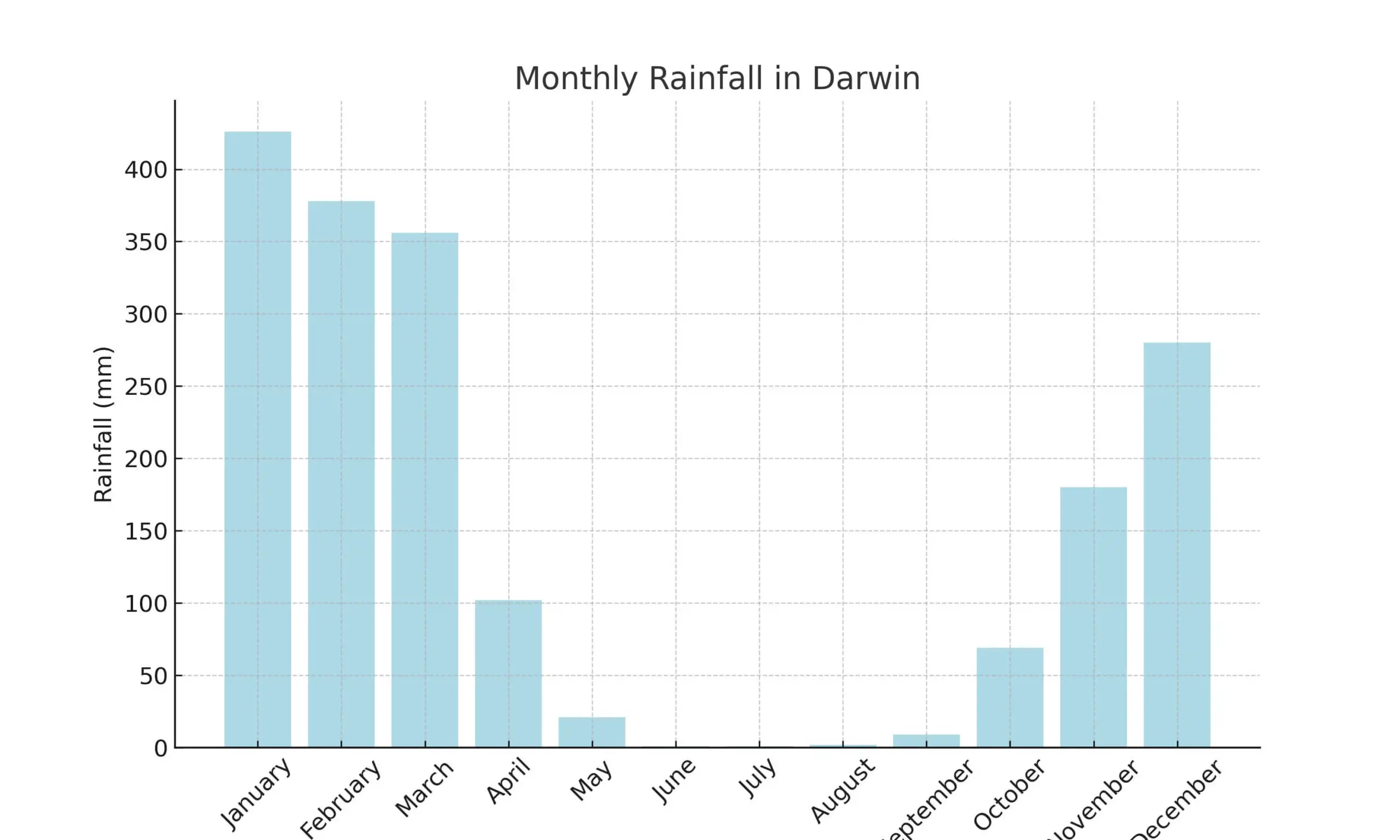Located inside the tropical embrace of Australia’s Northern Territory, Darwin is a metropolis that captivates with its specific combination of natural beauty, cultural richness, and all-around available electricity. As you think about embarking on a journey to this eye-catching destination, your timing will have a great impact on your enjoyment.
Darwin’s weather comprises two major seasons. May to September experiences a dry season with blue skies that is more fascinating for outdoor activities making it the peak season for visitations.
The October to April season is characterized by wet weather including heavy rainfall, occasional cyclones, and high humidity making the exploration of the city risky and challenging.
Whether you seek the fun of outdoor adventures, cultural festivities, or the silence of serene landscapes, knowledge of the temporal nuances could be your compass to unlocking the entire spectrum of Darwin’s appeal.

When is the Best Time to Visit Darwin
Darwin boasts a fascinating combination of vibrant subculture and breathtaking landscapes. The best time to enjoy her charm is at some stage in the dry season, from May to September.
These months provide delightful weather, characterized by clean skies, balmy temperatures, and minimum rainfall. The town comes alive with a plethora of outside sports, gala, and activities.
May marks the beginning of the dry season, with temperatures starting from 24°C to 32°C (seventy five°F to 90°F).
It’s the best time to explore the town’s attractions, embark on nature trails, and witness the lovely sunsets over the Timor Sea.
As June kicks in, the climate becomes cooler, with temperatures averaging between 21°C to 31°C (70°F to 88°F).
This duration is best for indulging in outside adventures like hiking in Litchfield National Park or taking a cruise along the Adelaide River to witness the famous leaping crocodiles.
July and August make the peak of Darwin’s visitor season. The weather remains pleasantly dry, with temperatures ranging from 20°C to 31°C (68°F to 88°F).
These months host diverse cultural festivals, together with the Darwin Festival, showcasing music, arts, and culinary delights from the region.
September marks the end of the dry season, with temperatures starting from 24°C to 33°C (75°F to 91°F).
It’s a high-quality time to visit Kakadu National Park and witness the breathtaking landscapes of their full glory before humidity and rainfall start to boom.


When is the Worst Time to Visit Darwin
October to April represents the wet season in Darwin. Characterized by high humidity, heavy rainfall, and occasional cyclones, this time is regularly considered less favorable for travelers.
From October to December, temperatures change drastically, averaging between 25°C to 33°C (77°F to 91°F).
The humidity may be stifling, making outside sports much less enjoyable.
January to March is the peak of the moist season, marked by extreme rainfall and humidity.
Temperatures range from 24°C to 32°C (75°F to 90°F), but the humidity could make it sense much hotter.
Flash floods and avenue closures are common at some point in this period, restricting outdoor activities.
April signals the transition from the wet to the dry season. While temperatures vary from 24°C to 32°C (75°F to 90°F), heavy rainfall persists, impacting outside activities.
However, toward the end of April, the climate starts to improve, making it a barely higher time to visit as compared to earlier in the wet season.
Cheapest Time to Visit Darwin
The moist season, extending from October to April emerges as a haven for budget-friendly travelers seeking reasonable options. Accommodation rates take a massive dip, offering options of lower-priced alternatives throughout the metropolis.
Airlines, acknowledging decreased calls, often sell discounted fares, rendering travel to Darwin greater financially available, making the season more affordable to visit.
However, it’s vital to weigh those cost advantages against the backdrop of boundaries imposed by heavy rainfall and pervasive humidity in the course of this period.
The primary purpose of visiting Darwin would be her outdoor activities which will be limited during this period making your stay less productive and fascinating.
Off-Season: Least Busy Time to Visit Darwin
The wet season, specifically from January to March, unveils Darwin at its quietest. This period experiences a high decline in tourist footfall, remodeling attractions into serene havens and making accommodations more affordable.
The crowds offer an intimate engagement with Darwin’s essence, allowing traffic a deeper and greater non-public connection with the city’s treasures.
However, embracing this off-season allure entails a readiness to navigate the well-known moist and humid conditions.
Most Expensive Time to Visit Darwin
The pinnacle of the dry season, especially in July and August, stands as Darwin’s more expensive time for travelers.
The lodges and tour packages, driven through renowned activities like the Darwin Festival, always escalates fees.
This busy duration witnesses a flurry of visitors, creating a crowded ecosystem that magnifies the attraction of Darwin’s cultural festivities, albeit at a much higher cost.
Hottest Months in Darwin
The scorching months of October and November are mostly referred to as Darwin’s zenith in temperature, boasting hovering highs of 33°C (91°F).
These months unravel a series of extreme warmth alleviated by the oppressive humidity, creating a harsh climate for outside endeavors.
The environment pulses with a sultry power, beckoning locals and traffic to seek refuge in shaded spots or indulge in aquatic escapes on the town’s lovely waterfronts.
Coldest Months in Darwin
While Darwin keeps a highly constant temperature range throughout the 12 months, the cooler months usually occur throughout June and July.
During this era, the temperatures range between 21°C to 22°C (70°F to 72°F), presenting a reprieve from the extra intense heat of the tropical climate.
The city’s atmosphere takes a refreshing turn because the mild temperatures invite locals and site visitors alike to explore outdoor sights, bask in strolls along the waterfront, or find pleasure in al fresco eating studies.
It’s a lovely time for outside activities, whether or not it is venturing into the nearby countrywide parks or taking inside the city’s cultural offerings without the sweltering heat that characterizes other components of the year.
Month-by-month weather in Darwin
A table showing Darwin’s weather month by month.
| Months | Average High (°C) | Average Low (°C) | Rainfall (mm) | Condition |
| January | 31 | 25 | 426 | Peak of rainfall with high humidity |
| February | 31 | 25 | 378 | Continuous heavy rainfall with humidity |
| March | 31 | 25 | 356 | Rainy and stifling humidity |
| April | 32 | 25 | 102 | Massive reduction in rainfall and humidity |
| May | 32 | 24 | 21 | Hot with occasional showers |
| June | 31 | 21 | 1 | Hot and sunny |
| July | 31 | 20 | 1 | Hot and sunny |
| August | 32 | 21 | 2 | Hot and sunny |
| September | 33 | 24 | 9 | Hot and cloudy |
| October | 33 | 25 | 69 | Increasing rainfall, higher temperatures |
| November | 33 | 26 | 180 | Rainy with higher temperatures |
| December | 32 | 25 | 280 | Heavy rainfall with higher temperatures. The peak of the wet season approaching. |
